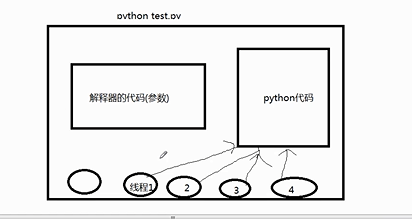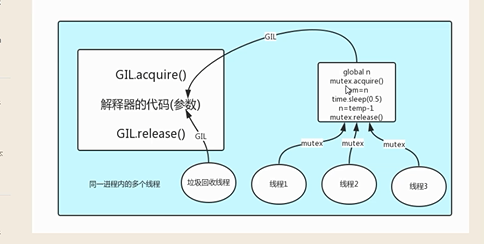多线程:
多线程和多进程的不同是他们占用的资源不一样,
一个进程里边可以包含一个或多个进程,
进程的开销大,线程的开销小。
打个比方来说:创建一个进程,就是创建一个车间。创建一个线程,就是在一个车间创建一个流水线。
怎么去开启一个线程:
方法一(直接用默认的类):
1 开启线程的方式一:使用替换threading模块提供的Thread 2 from threading import Thread 3 from multiprocessing import Process 4 5 def task(): 6 print('is running') 7 8 if __name__ == '__main__': 9 t=Thread(target=task,) 10 # t=Process(target=task,) 11 t.start() 12 print('主')
方法二(自己定义一个类,继承系统的类):
1 #开启线程的方式二:自定义类,继承Thread 2 from threading import Thread 3 from multiprocessing import Process 4 class MyThread(Thread): 5 def __init__(self,name): 6 super().__init__() #不破坏原有的类 7 self.name=name 8 def run(self): 9 print('%s is running' %self.name) 10 11 if __name__ == '__main__': 12 t=MyThread('egon') 13 # t=Process(target=task,) 14 t.start() 15 print('主')
在同时开始多个线程和多个进程的时候,多个线程的pid是不一样的,多个线程的pid是一样的。
可以利用这段代码测试下:
from threading import Thread from multiprocessing import Process import os def task(): print('%s is running' %os.getpid()) if __name__ == '__main__': # t1=Thread(target=task,) # t2=Thread(target=task,) t1=Process(target=task,) t2=Process(target=task,) t1.start() t2.start() print('主',os.getpid())
多个线程是共享同一个进程内的资源的。
Thread的其他相关的属性或者方法:
from threading import Thread,activeCount,enumerate,current_thread
import time
def task():
print('%s is running' %current_thread().getName())
time.sleep(2)
if __name__ == '__main__':
t=Thread(target=task,)
t.start()
t.join()
print(t.is_alive()) #判断线程是否是活着的
print(t.getName()) #获取到线程名
print(enumerate()) #显示当前活跃的进程对象
print('主')
print(activeCount()) #查看活着的线程数,一般是一个主进程(相当于也是一个线程)和开启的数量
current_thread的用法:
current_thread的用法
from threading import Thread,activeCount,enumerate,current_thread
from multiprocessing import Process
import time
def task():
print('%s is running' %current_thread().getName())
time.sleep(2)
if __name__ == '__main__':
p=Process(target=task)
p.start()
print(current_thread())
主线程从执行层面上代表了其所在进程的执行过程。
守护线程:
无论是进程还是线程,都是遵循:守护XXX会等待主XXX运行完毕后被销毁。
需要强调的是:运行完毕并非终止运行。
主进程运行完了还需要等待子进程运行。
先看:守护进程
from multiprocessing import Process
import time
def task1():
print('123')
time.sleep(1)
print('123done')
def task2():
print('456')
time.sleep(10)
print('456done')
if __name__ == '__main__':
p1=Process(target=task1)
p2=Process(target=task2)
p1.daemon = True #p1加了守护进程
p1.start()
p2.start()
print('主')
p1加了守护进程后,在主进程运行结束后,p1的进程也死掉。
p2没有加守护进程,在主进程运行结束后,p2会继续运行。
#再看:守护线程
from threading import Thread
import time
def task1():
print('123')
time.sleep(10)
print('123done')
def task2():
print('456')
time.sleep(1)
print('456done')
if __name__ == '__main__':
t1=Thread(target=task1)
t2=Thread(target=task2)
t1.daemon=True
t1.start()
t2.start()
print('主')
主线程会等其他线程(相当于子线程)运行完毕,程序才会结束。
如果(子)线程加上了守护线程,当主线程运行结束后,(子)线程没有运行结束的都会被干掉。
需要特别注意的一点,这里如果还有其他线程没有运行完,主线程是不会结束的。
GIL全局解释器锁:
GIL本质就是一把互斥锁。
这把锁的意义在于在代码执行的时候,防止多段代码抢占资源。
在Cpython解释器中,同一个进程下开启多个多线程,同一时刻只能有一个线程执行,无法利用多核优势。
from threading import Thread n=100 def task(): print('is running') if __name__ == '__main__': t1=Thread(target=task,) t2=Thread(target=task,) t3=Thread(target=task,) # t=Process(target=task,) t1.start() t2.start() t3.start() print('主')
比如说python执行这样一个程序:

python解释器除了自己开的线程外,还有一些其他的线程,比如说内存回收机制。
线程1,2,3,4都是同一段代码,这三段代码都是要交给python解释器来执行的。
当python代码和内存回收机制同时进行的时候,可能会将数据紊乱。
所以为了防止这种情况:
可以在解释器的代码前后加入这些代码:
GIL.acquire() 解释器的代码() GIL.release()

python多线程利用不了多核优势,多进程能够利用多核优势。
1 #线程的互斥锁 2 from threading import Thread,Lock 3 import time 4 n=100 5 def work(): 6 global n 7 mutex.acquire() #加GIL锁 8 temp=n 9 time.sleep(0.1) 10 n=temp-1 11 mutex.release() #解GIL锁 12 13 if __name__ == '__main__': 14 mutex=Lock() #造出这把所 15 l=[] 16 start=time.time() 17 for i in range(100): 18 t=Thread(target=work) 19 l.append(t) 20 t.start() 21 22 for t in l: 23 t.join() 24 print('run time:%s value:%s' %(time.time()-start,n))
互斥锁和join的区别:
上面的互斥锁的代码,下面是join的代码:
from threading import Thread,Lock
import time
n=100
def work():
time.sleep(0.05)
global n
temp=n
time.sleep(0.1)
n=temp-1
if __name__ == '__main__':
start=time.time()
for i in range(100):
t=Thread(target=work)
t.start()
t.join()
print('run time:%s value:%s' %(time.time()-start,n))
join和互斥锁的代码的区别是:
join是将每一个循环斗都执行了,相当于所有的代码串行了。
而互斥锁是只将加锁的代码串行,其他的代码串行。
总结一个结论:如果碰到的是纯IO的操作,利用不了多核优势,一般利用多线程。
如果碰到的是计算的操作,能够利用多核的优势,一般利用多进程。
#多线程
优点:开销小 缺点:不能利用多核优势 from threading import Thread from multiprocessing import Process import time #计算密集型 def work(): res=1 for i in range(100000000): res+=i if __name__ == '__main__': p_l=[] start=time.time() for i in range(4): # p=Process(target=work) #6.7473859786987305 p=Thread(target=work) #24.466399431228638 p_l.append(p) p.start() for p in p_l: p.join() print(time.time()-start) #从运算结果上得到结果可以看到,在有4核的机器上,纯计算的多线程程序能利用多核优势,多线程无法利用多核优势。
from threading import Thread
from multiprocessing import Process
import time
#IO密集型
def work():
time.sleep(2)
if __name__ == '__main__':
p_l=[]
start=time.time()
for i in range(400):
# p=Process(target=work) #12.104692220687866
p=Thread(target=work) #2.038116455078125
p_l.append(p)
p.start()
for p in p_l:
p.join()
print(time.time()-start)
#IO密集型程序能够利用单核优势,开线程比开进程的优势在于线程的资源比进程的资源小。
死锁与递归锁:
#死锁现象
#一个线程起来以后,运行函数F1内容(去抢A锁,然后去抢B锁,然后释放B锁,释放A锁),然后运行F2的程序(先抢B锁,然会抢A锁,等待一小下,然后释放A锁,释放B锁) #同时起了20个线程,当一个线程起来后,运行了A过程,其他线程抢不到A锁,当释放了A锁后,运行B过程,这时候抢到了B锁。其他线程抢到了A锁,第一个线程需要A锁,其他进程需要B锁,就会造成死锁现象。
from threading import Thread,Lock,RLock import time mutexA=Lock() mutexB=Lock() class Mythread(Thread): def run(self): self.f1() self.f2() def f1(self): mutexA.acquire() print('�33[45m%s 抢到A锁�33[0m' %self.name) mutexB.acquire() print('�33[44m%s 抢到B锁�33[0m' %self.name) mutexB.release() mutexA.release() def f2(self): mutexB.acquire() print('�33[44m%s 抢到B锁�33[0m' %self.name) time.sleep(1) mutexA.acquire() print('�33[45m%s 抢到A锁�33[0m' %self.name) mutexA.release() mutexB.release() if __name__ == '__main__': for i in range(20): t=Mythread() t.start()
解决死锁的问题可以利用递归锁:
#递归锁 RLock #RLock的运行原理:当锁一旦acquire的话,计数器+1,当锁release的话,计数器就减一。
#其他锁想抢占锁的时候,就必须得等到锁的计数器减到0才能抢占,这样就避免了死锁现象的发生。2017-09-06 from threading import Thread,Lock,RLock import time mutex=RLock() class Mythread(Thread): def run(self): self.f1() self.f2() def f1(self): mutex.acquire() print('�33[45m%s 抢到A锁�33[0m' %self.name) mutex.acquire() print('�33[44m%s 抢到B锁�33[0m' %self.name) mutex.release() mutex.release() def f2(self): mutex.acquire() print('�33[44m%s 抢到B锁�33[0m' %self.name) time.sleep(1) mutex.acquire() print('�33[45m%s 抢到A锁�33[0m' %self.name) mutex.release() mutex.release() if __name__ == '__main__': for i in range(20): t=Mythread() t.start()
信号量:
(本质也是一把锁,就好像是一个公共厕所,可以进多个人)
可以让有数量的进程一起运行。
from threading import Thread,current_thread,Semaphore
import time,random
#current_thread 得到线程的名称
#Semaphore 指定线程的最大运行数量函数
#定义最多允许5个进程同时运行
sm=Semaphore(5)
def work():
sm.acquire()
print('%s 上厕所' %current_thread().getName())
time.sleep(random.randint(1,3))
sm.release()
if __name__ == '__main__':
for i in range(20):
t=Thread(target=work)
t.start()
信号量的执行是你先创造几把锁,这样就定义了同时能够运行的最大数量。
当有一个线程(或进程)运行了以后,拿走一个锁,count+1.当线程(或线程)运行完毕以后,count-1.
这时候其他的进程或者线程才能够再去抢这把锁。
事件Event:
一共两个进程(或者进程),第二个进程的执行需要得到第一个的执行结果才能执行。
例如说连接数据库需要两个进程,一个检测数据库是否可以连接,一个连接。from threading import Thread,current_thread,Evenimport timeevent=Event()
def conn_mysql(): count=1 while not event.is_set(): if count > 3: raise ConnectionError('链接失败') print('%s 等待第%s次链接mysql' %(current_thread().getName(),count)) event.wait(0.5)
#这里设置的wait是等下面check_mysql的event设置为True count+=1 print('%s 链接ok' % current_thread().getName()) def check_mysql(): print('%s 正在检查mysql状态' %current_thread().getName()) time.sleep(1)
#这里是将event设置为True event.set() if __name__ == '__main__': t1=Thread(target=conn_mysql) t2=Thread(target=conn_mysql) check=Thread(target=check_mysql) t1.start() t2.start() check.start()
定时器:
from threading import Timer def hello(n): print("hello, world",n) t = Timer(3, hello,args=(11,)) t.start() # after 1 seconds, "hello, world" will be printed #定义了以后在几秒以后执行
线程queue:
针对于线程,不针对于进程
import queue #这个是针对于线程的
# q=queue.Queue(3) #队列:先进先出 # q.put(1) # q.put(2) # q.put(3) # # print(q.get()) # print(q.get()) # print(q.get()) # q=queue.LifoQueue(3) #堆栈:后进先出 # q.put(1) # q.put(2) # q.put(3) # # print(q.get()) # print(q.get()) # print(q.get()) q=queue.PriorityQueue(3) #数字越小优先级越高
#前面放的是优先级,数字越小优先级越高
q.put((10,'data1')) q.put((11,'data2')) q.put((9,'data3')) print(q.get()) print(q.get()) print(q.get())
进程池与线程池:
这个模块提高了一个更高级的接口来异步调用。
异步调用就是将一堆任务直接丢到进程池或者线程池,不用等待执行完成。
同步调用是将任务丢到进程池或者线程池,还要等待他的执行结果。
线程池:
from concurrent.futures import ProcessPoolExecutor,ThreadPoolExecutor
#引用线程池和进程池函数
from threading import current_thread import os,time,random def work(n): print('%s is running' %current_thread().getName()) time.sleep(random.randint(1,3)) return n**2 if __name__ == '__main__': p=ThreadPoolExecutor()
#生成一个线程池 objs=[] for i in range(21): obj=p.submit(work,i)
#将所有线程提交到线程池 objs.append(obj) p.shutdown()
#等待所有线程结束
#打印线程池内的线程 for obj in objs: print(obj.result())
进程池:
from concurrent.futures import ProcessPoolExecutor,ThreadPoolExecutor from threading import current_thread import os,time,random def work(n): print('%s is running' %current_thread().getName()) time.sleep(random.randint(1,3)) return n**2 if __name__ == '__main__': p=ThreadPoolExecutor() objs=[] for i in range(21): obj=p.submit(work,i) objs.append(obj) p.shutdown() for obj in objs: print(obj.result())
模拟IO密集型操作,看看是进程池的程序好还是线程池的程序好:
模拟下载网页的过程:(IO需要等待下载)
进程池:
1 进程池 2 import requests #pip3 install requests 3 import os,time 4 from multiprocessing import Pool 5 from concurrent.futures import ProcessPoolExecutor,ThreadPoolExecutor 6 def get_page(url): 7 print('<%s> get :%s' %(os.getpid(),url)) 8 respone = requests.get(url) 9 if respone.status_code == 200: 10 return {'url':url,'text':respone.text} 11 12 def parse_page(obj): 13 dic=obj.result() 14 print('<%s> parse :%s' %(os.getpid(),dic['url'])) 15 time.sleep(0.5) 16 res='url:%s size:%s ' %(dic['url'],len(dic['text'])) #模拟解析网页内容 17 with open('db.txt','a') as f: 18 f.write(res) 19 20 21 if __name__ == '__main__': 22 23 # p=Pool(4) 24 p=ProcessPoolExecutor() 25 urls = [ 26 'http://www.baidu.com', 27 'http://www.baidu.com', 28 'http://www.baidu.com', 29 'http://www.baidu.com', 30 'http://www.baidu.com', 31 'http://www.baidu.com', 32 'http://www.baidu.com', 33 ] 34 35 36 for url in urls: 37 # p.apply_async(get_page,args=(url,),callback=parse_page) 38 p.submit(get_page,url).add_done_callback(parse_page) 39 40 p.shutdown() 41 print('主进程pid:',os.getpid())
线程池:

1 线程池 2 import requests #pip3 install requests 3 import os,time,threading 4 from multiprocessing import Pool 5 from concurrent.futures import ProcessPoolExecutor,ThreadPoolExecutor 6 def get_page(url): 7 print('<%s> get :%s' %(threading.current_thread().getName(),url)) 8 respone = requests.get(url) 9 if respone.status_code == 200: 10 return {'url':url,'text':respone.text} 11 12 def parse_page(obj): 13 dic=obj.result() 14 print('<%s> parse :%s' %(threading.current_thread().getName(),dic['url'])) 15 time.sleep(0.5) 16 res='url:%s size:%s ' %(dic['url'],len(dic['text'])) #模拟解析网页内容 17 with open('db.txt','a') as f: 18 f.write(res) 19 20 21 if __name__ == '__main__': 22 23 # p=Pool(4) 24 p=ThreadPoolExecutor(3) 25 urls = [ 26 'http://www.baidu.com', 27 'http://www.baidu.com', 28 'http://www.baidu.com', 29 'http://www.baidu.com', 30 'http://www.baidu.com', 31 'http://www.baidu.com', 32 'http://www.baidu.com', 33 ] 34 35 36 for url in urls: 37 # p.apply_async(get_page,args=(url,),callback=parse_page) 38 p.submit(get_page,url).add_done_callback(parse_page) 39 40 p.shutdown() 41 print('主进程pid:',os.getpid())
